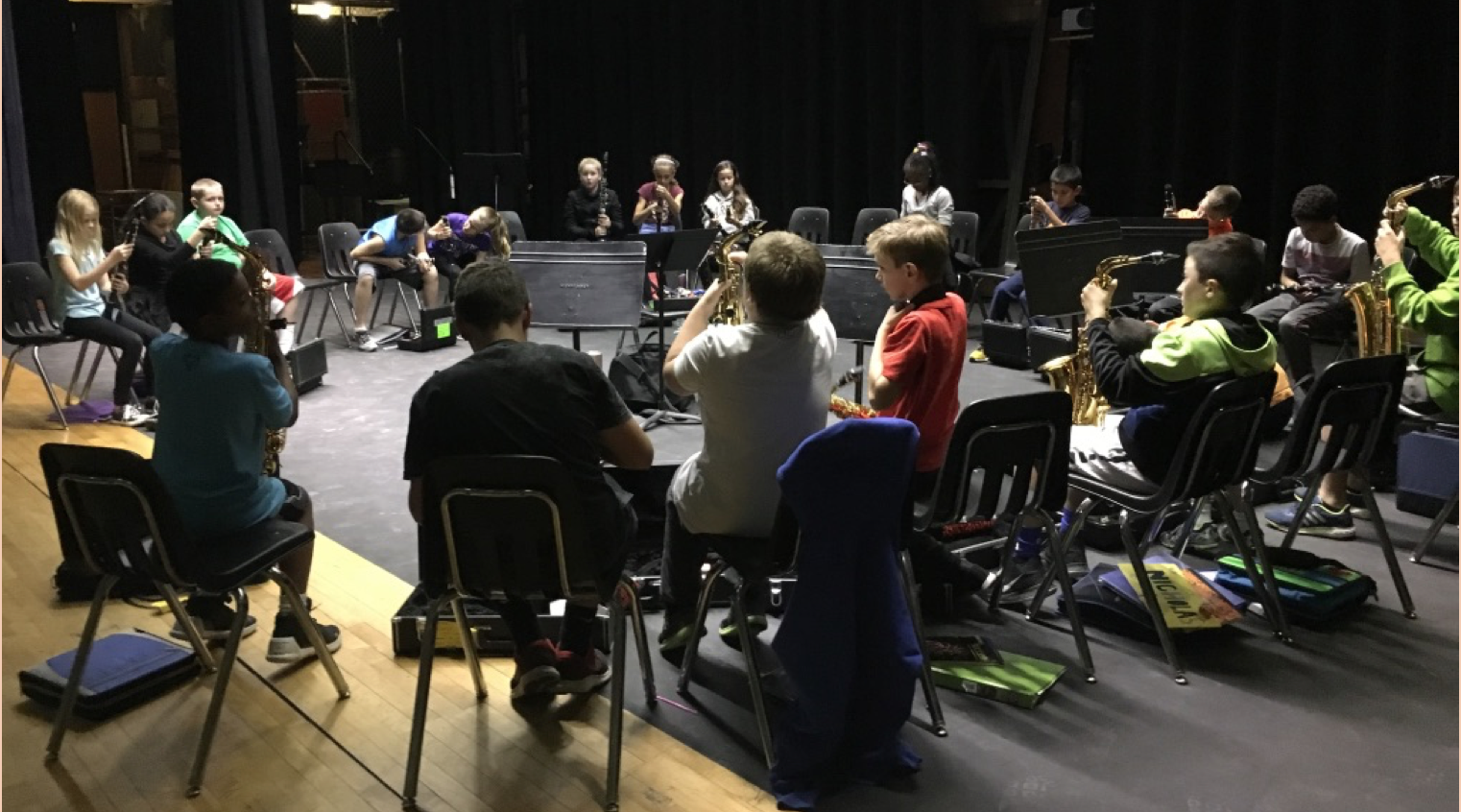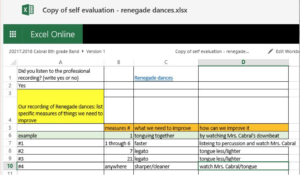Ways to Mix up your Large Ensemble Rehearsals

Sometimes you just need a change in your rehearsal. I have utilized these ideas as rehearsal mix it ups, as rewards or just for a change. Students become very reliant on the people they sit next to whether they realize it or not. As we work to get students outside of their little “bubble” of their own instrument, these are ways to get students listening for other parts in the ensemble. As you move the students around the room, they will begin to hear other parts because they have no choice. When you mix up your rehearsals, the clarinet player may now be sitting next to a trumpet or a trombone player. When I do mix it up days, the student feedback also becomes a great way to plan future rehearsals. Suddenly, the students realize they are too reliant on their section for coming in during an entrance, or they realize they have never actually heard the countermelody in the trombone section.
I often realize that students are relying TOO much on me as the conductor and leader. While I want students to watch for cues, I realize students are not counting rests, or listening to other parts to learn when their entrance is, they are just watching me to tell them when to come in. As I conduct and lead on mix it up days, I often mix up where I am standing as well. As you will see from these different ideas, there could be days when the way we mix it up means I physically cannot stand in front of all students. There are days when I will teach from the percussion section instead of the front of the room. This can lead to great discussions with the students about who should they listen for before an entrance. Do they have a call and response section with someone else? Are they finishing a though that was started by another section? Do they enter after a percussion section? What else is going on in the piece they can listen to.
If you teach in a district where you are lucky enough to have multiple band teachers, or you may be sharing your band room with the orchestra or general music teacher, you will need to discuss with them some of these ideas before utilizing them. There are many ways to mix it up where you do not need to disrupt the actual chairs in the room, but I have also included ideas where you may have to get colleagues on board because there is not enough time between classes to fix the chairs back to normal.
Each day I have my agenda for the day on our smartboard. For these mix it up days, I put on the board “Mix it up day” and I give the students the directions for mixing it up. Students have a routine of checking the board when they walk into the room, so if I want to change my seating around it becomes very easy to communicate it to students without wasting rehearsal time to change our seats.
Without any more “talk,” here are the mix it up ideas……..
MIX THE STUDENTS UP
- Allow students to sit anywhere in the room.
- Allow students to sit anywhere with parameters. Parameters such as:
- You must sit in a different row then you usually sit in
- You must sit on a different side of the room then you usually sit on
- You cannot sit next to the same person you usually sit with
- You cannot sit next to someone who plays the same instrument as you
- Most often I pick multiple parameters to give the students
- As students enter the classroom have them pick a number from a cup. Have numbers 1, 2, 3, and 4 in the cup and whichever number they pick they must sit in that row. Just remember to make more number 4s then 3, 2, or 1 because your 4th row is probably your largest! Same with 3s, etc.
- As students enter into the room have them follow the leader to seats in order as they entered into the classroom. For example, the first student that enters sits in row 1 seat 1, the second student the enters sits in row 1 seat 2. We often do this with 5th grade band because students come to class with their instruments and do not use lockers.
- Change an entire section or row. sometimes proximity to the front of the room is all you need to change your rehearsal
- Row 1 go to Row 2; Row 2 go to Row 3, etc.
- Row 1 and Row 4 switch
- Trumpets come to row 1, and Row 1 go to row 4 to accommodate (This might split your clarinet and flute section if you are utilizing two rows for clarinets and flutes but that is OK)
MIX THE ROOM UP
- Put the room in a circle
- YES I AM SERIOUS. Here is a situation where if you share a room with other directors or ensembles, you would have to convince them to do this too especially if you have rehearsals back to back
- If there are too many chairs, make an outer and an inner circle.
- You can still assign where students sit within the circle, or you can let them sit anywhere. For example, flutes and clarinets go to the middle row, etc.
- You can teach and conduct from the middle, from the outside, from the percussion section
This will also force you as the director to move around the room

(Students setting up instruments while in a circle!)

- Make straight rows instead of curves
- Allow for a break in the middle of the row so that you can walk up and down the rows
- You could keep the students in the same seats when they are curved, but you just might need to move a few instruments around because you probably cannot fit 20 chairs in a straight row for row 4, if you usually have 20 chairs in curves in row 4.
- Flip everyone but the percussion.
Have the percussion stay in their spots but reverse the chairs for the band so they face the percussionists. You could then either have row 4 be the first row facing the percussionists, or you could move row 1 to the first row facing the percussionists.
MIX THE REHEARSAL UP
- Have a silent rehearsal
- You could have a silent rehearsal where the teacher can speak but no one else can (this could be used as a disciplinary measure too) or…..
- You can have a silent rehearsal where no one speaks including the teacher. This makes non-verbal communication very important. (This can be a fun way to mix it up in silence)
- Have a student lead rehearsal (well…. Student driven rehearsals)
- For myself, I need to control this a little but have the students give suggestions for what to rehearse.
- Self-reflection: Have the students listen to a recording of their performance and write down individual measures or sections that they think needs improvement. You can then take student suggestions for measure or sections.
- This could all be done during class or as a flipped classroom activity. Students could listen during class and either hand in their suggestions, and then you as the teacher could put together a list of rehearsal spots, OR you could listen during class and then students could raise hands to give suggestions of where to rehearse.
- If it was a flipped classroom activity, you as the teacher would have time to look through the students suggestions prior to class


Click on images to enlarge.
- Have student lead warm-ups
Have students perform the Concentration exercise (see “Do Sweat the Small Stuff – Ensembles” for explanation) and instead of you leading the exercise at the beginning of class. Have students do it. Students can be leading rehearsal and other students should watch the student as conductor.

Often during mix it up days you will find out which students have been relying on each other for music, pencils, and just being prepared. Even if you do regular music and pencil checks, it can be easy for students to ‘hide’ that they are not prepared all the time for class. By not allowing students to sit next to anyone that plays their instrument, they cannot share music. This is especially telling if you have a rehearsal space where students share music stands. Mixing up your rehearsal can keep not only the students on their toes but you as well!
Meghan Cabral teaches middle school band and works in Carmel, NY. Meghan is a Grammy Nominated Semi-Finalist, has written for many music publications including The Instrumentalist Magazine, NAfME’s Teaching Music, MEJ, NYSBDA’s Band Stand, as well as NYSSMA’s School Music News. Meghan is an active guest conductor as well as clinician for music departments and at state conferences. You can follow Meghan on twitter @band_mcabral, or Instagram @band_cabral or contact her at anewbandapproach@gmail.com.
Related Reading:
2o Analogies That I Have Used in Band Rehearsal (With Love) That You Have Not
Contagious Engagement in Band
Do Sweat the Small Stuff: Full Band Ensemble Tips
Learn. Share. Inspire.
BandDirectorsTalkShop.com






Leave a Reply
You must be logged in to post a comment.